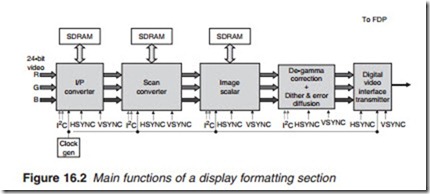Video formatting
Figure 16.2 illustrates main functions of a display formatting section of a FPD.
De-interlacing
Unlike the television broadcasts and the CRT in which interlace scanning is used, flat panels are progressively scanned. Hence, the first task of the formatting section is to de-interlace the video using an interlace/progres- sive (I/P) converter.
The process involves the creation of new scan lines and inserts them between the existing lines of an interlaced field. This is not simply insert- ing even lines of an even field in between the odd lines of the previous odd field. As a result of the time difference between the two fields and the movement that may have occurred during that time, even lines of an even
field are different from the actual missing even lines in a previous odd field.
Several techniques may be used including the very simple line repeat to the very complex motion adaptation and compensation. I/P conversion normally results in artefacts caused by abrupt frame transitions. Some sort of filtering is therefore desirable to smooth out high frequencies.
There are four different techniques available for de-interlacing a video signal: Intra-field, inter-field, motion adaptive and motion compensation.
Intra-field I/P conversion
In this simple technique, data from the same field are used to obtain the missing lines. There are two types of infra-field de-interlacing: line repeat and line average. In the line repeat also known as line doubling technique, the contents of each line are repeated field by field resulting in the follow- ing sequence: 1, 1, 3, 3, 5, 5 and so on for the odd field and 2, 2, 4, 4, 6, 6 and so on for the even field. In the line-averaging technique, also known as ‘Bob’ or interpolating technique, a scan line is added to a following line and the average of the two is inserted as the missing line. The sequence for the odd field will thus be
Line 1, Average of lines 1 and 3, Line 3, Average of lines 3 and 5 and so on.
Similarly for the even field.
The major advantage of intra-field I/P conversion is that, unlike other progressive-scan techniques, they do not use multiple fields of data and hence do not require field data storage, translating into lower system manufacturing cost. The penalty paid is in terms of performance, intra-field converters being characterised by horizontal line flicker, still area flicker and a relatively low resolution.
Inter-field I/P conversion
Inter-field I/P conversion, also known as ‘Weave’, combines data from odd and even fields. Two or more fields may be involved. The new line is created by referring to the current as well as to the previous and/or next field. The odd lines of an odd field are incorporated in the even field and vice versa. This technique does not take account of motion between fields resulting; a ‘tearing’ artefact may appear in moving areas.
Motion-adaptive I/P conversion
In this technique either intra- or inter-field method is used depending on the motion between successive interlaced fields. A ‘motion value’ is produced by comparing successive fields and this is then used to determine the ‘bias’ towards the intra- or the inter-field method. For large ‘motion values’ with large variation between the successive video fields, interpolation is biased towards using intra-field components. In this case, use of inter-field data in the presence of motion would result in visible motion artefacts due to the lack of correlation between the current and previous field. However, for small motion values, a high degree of temporal correlation exists between adjacent video fields, and hence a heavy weighting to the inter-field component is given. Motion detection and estimation is therefore critical in this method.
Motion compensation I/P conversion
In this method, the picture content of successive fields are analysed to find out if there is motion from one field to the next. If motion is detected, a full field is then constructed and weaved into the intervening scan lines.
